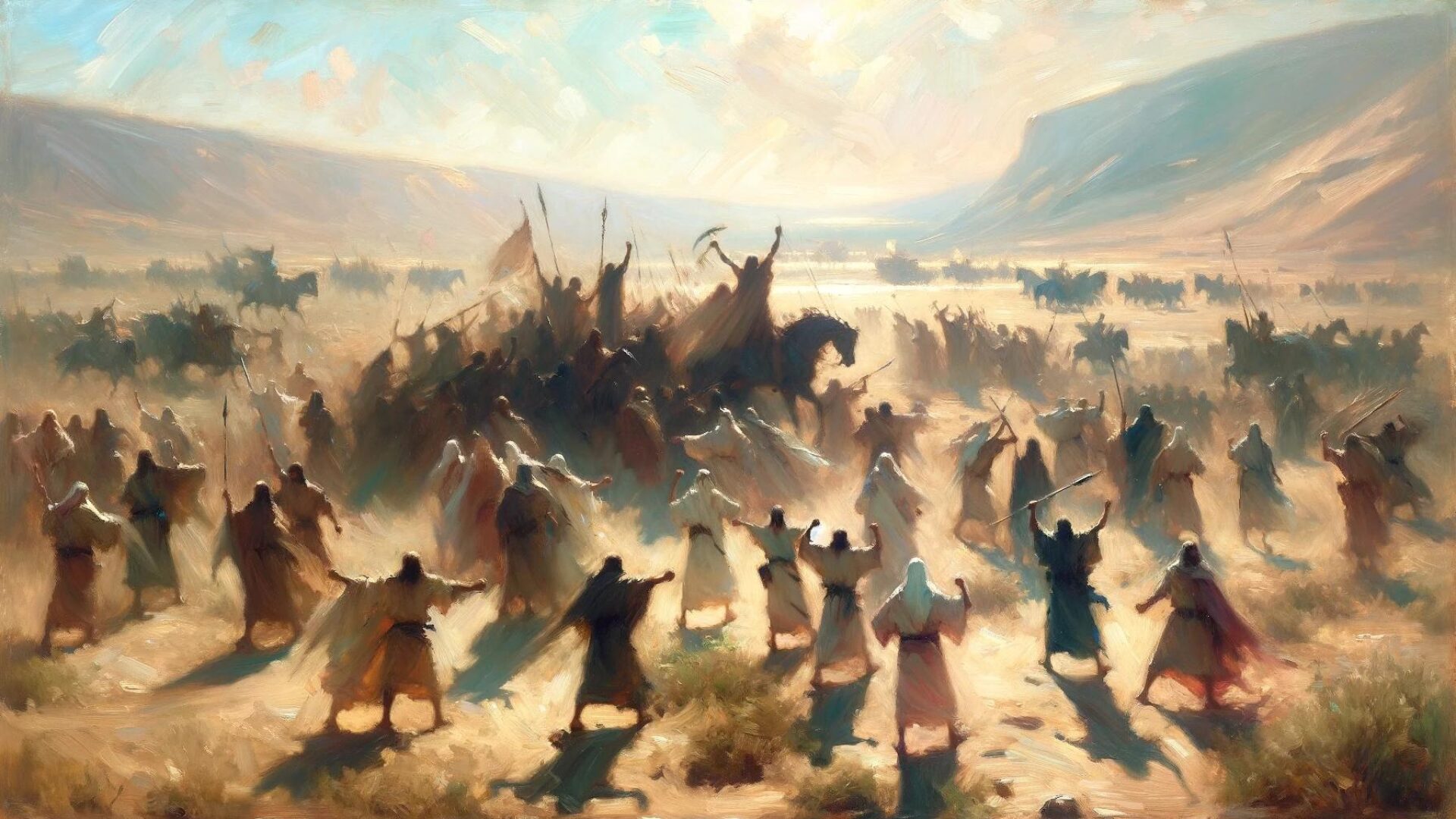The crucifixion of Jesus Christ stands as one of the most pivotal events in human history, marking the culmination of Jesus’ ministry on earth.
In the days and hours leading up to his crucifixion, Jesus experienced a range of emotionally charged encounters and events that tested his faith and fortitude. From the intimacy of the Last Supper to the isolation of the Garden of Gethsemane to the injustice of his trials, Jesus faced escalating challenges even as he resolved to fulfill his divine mission.
Ultimately, it was through the sacrifice of the cross that Jesus expressed the depths of God’s love for humanity. Jesus’ crucifixion and the events preceding it reveal the courage, compassion, and spiritual power that continue to inspire Christians today.
Jesus’ Final Days and the Passion of Christ
As the culmination of his ministry on earth, the final days of Jesus Christ are of immense importance to Christians around the world.
These days were marked by several significant events, including the Last Supper, Jesus’ arrest, and his trial. The Last Supper was a moment of great significance for Jesus and his disciples. During this final meal, Jesus predicted his betrayal and arrest while also establishing the ritual of communion.
Soon after the Last Supper, Jesus was arrested in the Garden of Gethsemane, where he had gone to pray. This event was the beginning of a brutal chain of events that would lead to his crucifixion. Jesus endured an unfair trial before the religious and political authorities of the time, eventually being sentenced to death by crucifixion.
The Passion of Christ, or the physical and emotional suffering that he endured leading up to his crucifixion, was unimaginable. Jesus was flogged, beaten, and mocked before being forced to carry his own cross to the site of his execution.
Throughout all of these events, Jesus remained steadfast in his faith and committed to his mission on earth. His sacrifice on the cross is a symbol of hope and redemption for Christians around the world, marking the ultimate expression of God’s love for humanity.
The Garden of Gethsemane
The Garden of Gethsemane is a significant location in the final days of Jesus Christ. It is where Jesus retreated to pray with his disciples before his arrest. The name Gethsemane means “olive press,” indicating that it was likely an olive grove where olives were harvested and pressed for oil.
As described in the Bible, Jesus prayed in the garden while his disciples slept. He asked God to take the cup of suffering away from him, but ultimately accepted God’s will and resolved to undergo the crucifixion for the sake of humanity.
“Father, if you are willing, take this cup from me; yet not my will, but yours be done.” – Luke 22:42
The Garden of Gethsemane is a symbol of the emotional and spiritual struggle that Jesus experienced in the lead-up to his crucifixion. It highlights the depth of his sacrifice and the profound impact it has on Christian theology and belief.
The Betrayal of Jesus
One of the most significant events leading up to the crucifixion of Jesus was his betrayal by Judas Iscariot, one of his own disciples. According to the Gospels, Judas agreed to betray Jesus to the chief priests and elders for thirty pieces of silver.
This act of betrayal proved to be the catalyst for Jesus’ arrest, trial, and subsequent crucifixion. It was a pivotal moment in the narrative of Jesus’ life and marked a turning point in the history of Christianity.
Throughout history, there have been many interpretations of Judas’ motives for betraying Jesus. Some have suggested that he was motivated by greed or personal gain, while others have argued that he may have been disillusioned by Jesus’ message or felt that his actions were necessary to push Jesus towards fulfilling his prophesied destiny.
Regardless of the reasons behind Judas’ actions, his betrayal of Jesus remains one of the most poignant and dramatic moments in the story of Jesus’ life and teachings. It serves as a powerful reminder of the complexities of human nature and the role that individuals can play in shaping the course of history.
The Trial of Jesus
The trial of Jesus before Pontius Pilate was a significant event that took place during the final days of his life. Pilate, the governor of Judea, held the power to decide Jesus’ fate, and the trial was a crucial moment in the lead-up to his crucifixion.
The trial began with the Jewish authorities bringing Jesus before Pilate and accusing him of various crimes, including blasphemy and inciting rebellion against the Roman empire. Pilate questioned Jesus, but found no evidence to support the charges against him. Despite this, he was under pressure from the Jewish crowd, who demanded that Jesus be put to death.
In an attempt to appease the crowd, Pilate offered them a choice between releasing Jesus or a notorious criminal named Barabbas. The crowd chose Barabbas, and Pilate reluctantly agreed to sentence Jesus to death by crucifixion.
The trial of Jesus was a complex political and religious affair, with many factors contributing to his eventual crucifixion. Scholars have debated the historical accuracy of the accounts of the trial, but it remains a significant event in the story of Jesus’ life and the foundation of Christianity.
The Crucifixion of Jesus in Biblical Accounts
The crucifixion of Jesus is a crucial event in Christian theology and is described in detail in several books of the New Testament, including the four gospels and the Epistles of Paul.
The physical aspect of Jesus’ crucifixion is described as a gruesome and torturous process involving the use of nails to attach his hands and feet to a wooden cross. This act represented the ultimate sacrifice of Jesus for the sins of humanity.
The symbolic aspect of Jesus’ crucifixion is equally important to Christians. In his death, Jesus represented the ultimate sacrifice of pure love, offering himself as a ransom for the sins of mankind. This selfless act allowed humanity to be reconciled with God and receive salvation.
“For God so loved the world that he gave his one and only Son, that whoever believes in him shall not perish but have eternal life.” – John 3:16
Beyond the physical and symbolic aspects, the crucifixion of Jesus holds deep theological significance for Christians. It is seen as the ultimate example of sacrificial love and represents a victory over sin and death.
Moreover, the death of Jesus on the cross paved the way for his resurrection, which is considered one of the most significant events in Christian history. His resurrection is seen as a triumph over death and represents hope and new life for believers.
In conclusion, the crucifixion of Jesus is a foundational event in Christian theology and is described in detail in biblical accounts. It represents a sacrifice of selfless love, victory over sin and death, and offers hope and salvation to believers.
The Cross and Resurrection
For Christians, the crucifixion of Jesus on the cross represents a significant event in the history of humanity and has been the centerpiece of Christian faith for over two thousand years. However, the cross is not the full story. The resurrection of Jesus that followed transformed the cross from a symbol of death and suffering into a symbol of hope and salvation.
The cross represents the ultimate sacrifice that Jesus made for humanity. By dying on the cross, he took upon himself the sins of the world and opened the way to eternal life for all who believe in him.
The resurrection of Jesus on the third day after his crucifixion is the cornerstone of Christian belief. It represents the ultimate victory over death and signifies the hope of eternal life for all who believe in him. Through his resurrection, Jesus triumphed over sin and death, and opened the way to new life for all who believe in him.
Together, the cross and the resurrection represent the ultimate expression of God’s love for humanity. They are a powerful reminder of the depth of God’s love and the incredible sacrifice that Jesus made for us.
As Christians around the world celebrate the death and resurrection of Jesus each year, they are reminded of the hope and promise that these events bring. They are inspired to live their lives in a way that reflects the love and sacrifice that Jesus demonstrated on the cross and the hope of eternal life that his resurrection brings.
Conclusion
Exploring the events leading up to the crucifixion of Jesus Christ reveals the depth of his sacrifice and the incredible love he had for humanity. From his final days to the trials and betrayals, each moment leading up to his crucifixion was marked by a profound spiritual and emotional struggle, culminating in his ultimate sacrifice on the cross.
The Garden of Gethsemane and Jesus’ prayer show the depth of his humanity and the incredible burden he carried. The betrayal of Judas Iscariot and the trial before Pontius Pilate highlight the political and religious factors that ultimately led to his crucifixion.
Examining the biblical accounts of his crucifixion demonstrates the physical and symbolic aspects of his sacrifice and the theological significance it holds for Christians. The cross and Jesus’ resurrection are the ultimate expressions of hope and redemption, reminding us of the incredible power of faith and love.
In conclusion, the crucifixion of Jesus Christ remains one of the most significant events in human history, transforming countless lives and inspiring hope and faith across the globe. May we always remember the sacrifice and love that led to his crucifixion and the hope that the cross and resurrection bring to our lives.





